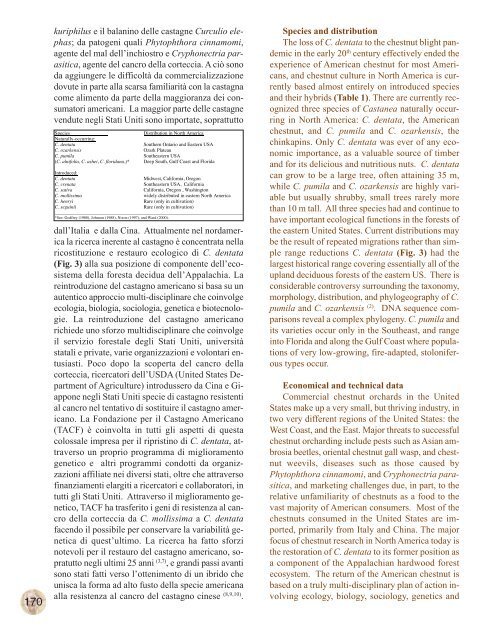Sulle Orme del Castagno - Acta Horticulturae
Sulle Orme del Castagno - Acta Horticulturae
Sulle Orme del Castagno - Acta Horticulturae
Create successful ePaper yourself
Turn your PDF publications into a flip-book with our unique Google optimized e-Paper software.
170<br />
kuriphilus e il balanino <strong>del</strong>le castagne Curculio elephas;<br />
da patogeni quali Phytophthora cinnamomi,<br />
agente <strong>del</strong> mal <strong>del</strong>l’inchiostro e Cryphonectria parasitica,<br />
agente <strong>del</strong> cancro <strong>del</strong>la corteccia. A ciò sono<br />
da aggiungere le difficoltà da commercializzazione<br />
dovute in parte alla scarsa familiarità con la castagna<br />
come alimento da parte <strong>del</strong>la maggioranza dei consumatori<br />
americani. La maggior parte <strong>del</strong>le castagne<br />
vendute negli Stati Uniti sono importate, soprattutto<br />
Species Distribution in North America<br />
Naturally-occurring:<br />
C. dentata Southern Ontario and Eastern USA<br />
C. ozarkensis Ozark Plateau<br />
C. pumila Southeastern USA<br />
(C. alnifolia, C. ashei, C. floridana,)* Deep South, Gulf Coast and Florida<br />
Introduced:<br />
C. dentata Midwest, California, Oregon<br />
C. crenata Southeastern USA, California<br />
C. sativa California, Oregon , Washington<br />
C. mollissima wi<strong>del</strong>y distributed in eastern North America<br />
C. henryi Rare (only in cultivation)<br />
C. seguinii Rare (only in cultivation)<br />
_____________________________________________________________________________<br />
*See: Godfrey (1988), Johnson (1988), Nixon (1997), and Ward (2000).<br />
dall’Italia e dalla Cina. Attualmente nel nordamerica<br />
la ricerca inerente al castagno è concentrata nella<br />
ricostituzione e restauro ecologico di C. dentata<br />
(Fig. 3) alla sua posizione di componente <strong>del</strong>l’ecosistema<br />
<strong>del</strong>la foresta decidua <strong>del</strong>l’Appalachia. La<br />
reintroduzione <strong>del</strong> castagno americano si basa su un<br />
autentico approccio multi-disciplinare che coinvolge<br />
ecologia, biologia, sociologia, genetica e biotecnologie.<br />
La reintroduzione <strong>del</strong> castagno americano<br />
richiede uno sforzo multidisciplinare che coinvolge<br />
il servizio forestale degli Stati Uniti, università<br />
statali e private, varie organizzazioni e volontari entusiasti.<br />
Poco dopo la scoperta <strong>del</strong> cancro <strong>del</strong>la<br />
corteccia, ricercatori <strong>del</strong>l’USDA (United States Department<br />
of Agriculture) introdussero da Cina e Giappone<br />
negli Stati Uniti specie di castagno resistenti<br />
al cancro nel tentativo di sostituire il castagno americano.<br />
La Fondazione per il <strong>Castagno</strong> Americano<br />
(TACF) è coinvolta in tutti gli aspetti di questa<br />
colossale impresa per il ripristino di C. dentata, attraverso<br />
un proprio programma di miglioramento<br />
genetico e altri programmi condotti da organizzazioni<br />
affiliate nei diversi stati, oltre che attraverso<br />
finanziamenti elargiti a ricercatori e collaboratori, in<br />
tutti gli Stati Uniti. Attraverso il miglioramento genetico,<br />
TACF ha trasferito i geni di resistenza al cancro<br />
<strong>del</strong>la corteccia da C. mollissima a C. dentata<br />
facendo il possibile per conservare la variabilità genetica<br />
di quest’ultimo. La ricerca ha fatto sforzi<br />
notevoli per il restauro <strong>del</strong> castagno americano, sopratutto<br />
negli ultimi 25 anni (3,7) , e grandi passi avanti<br />
sono stati fatti verso l’ottenimento di un ibrido che<br />
unisca la forma ad alto fusto <strong>del</strong>la specie americana<br />
alla resistenza al cancro <strong>del</strong> castagno cinese (8,9,10) .<br />
Species and distribution<br />
The loss of C. dentata to the chestnut blight pandemic<br />
in the early 20 th century effectively ended the<br />
experience of American chestnut for most Americans,<br />
and chestnut culture in North America is currently<br />
based almost entirely on introduced species<br />
and their hybrids (Table 1). There are currently recognized<br />
three species of Castanea naturally occurring<br />
in North America: C. dentata, the American<br />
chestnut, and C. pumila and C. ozarkensis, the<br />
chinkapins. Only C. dentata was ever of any economic<br />
importance, as a valuable source of timber<br />
and for its <strong>del</strong>icious and nutritious nuts. C. dentata<br />
can grow to be a large tree, often attaining 35 m,<br />
while C. pumila and C. ozarkensis are highly variable<br />
but usually shrubby, small trees rarely more<br />
than 10 m tall. All three species had and continue to<br />
have important ecological functions in the forests of<br />
the eastern United States. Current distributions may<br />
be the result of repeated migrations rather than simple<br />
range reductions C. dentata (Fig. 3) had the<br />
largest historical range covering essentially all of the<br />
upland deciduous forests of the eastern US. There is<br />
considerable controversy surrounding the taxonomy,<br />
morphology, distribution, and phylogeography of C.<br />
pumila and C. ozarkensis (2) . DNA sequence comparisons<br />
reveal a complex phylogeny. C. pumila and<br />
its varieties occur only in the Southeast, and range<br />
into Florida and along the Gulf Coast where populations<br />
of very low-growing, fire-adapted, stoloniferous<br />
types occur.<br />
Economical and technical data<br />
Commercial chestnut orchards in the United<br />
States make up a very small, but thriving industry, in<br />
two very different regions of the United States: the<br />
West Coast, and the East. Major threats to successful<br />
chestnut orcharding include pests such as Asian ambrosia<br />
beetles, oriental chestnut gall wasp, and chestnut<br />
weevils, diseases such as those caused by<br />
Phytophthora cinnamomi,andCryphonectria parasitica,<br />
and marketing challenges due, in part, to the<br />
relative unfamiliarity of chestnuts as a food to the<br />
vast majority of American consumers. Most of the<br />
chestnuts consumed in the United States are imported,<br />
primarily from Italy and China. The major<br />
focus of chestnut research in North America today is<br />
the restoration of C. dentata to its former position as<br />
a component of the Appalachian hardwood forest<br />
ecosystem. The return of the American chestnut is<br />
based on a truly multi-disciplinary plan of action involving<br />
ecology, biology, sociology, genetics and

















